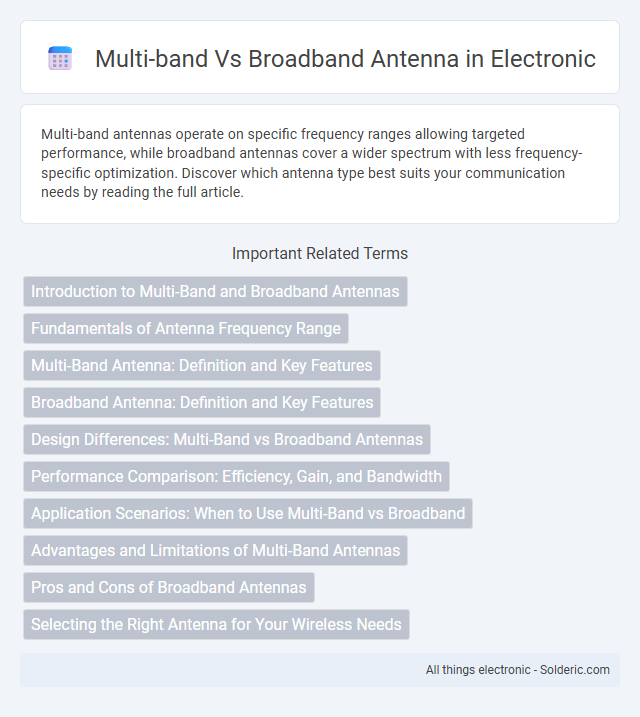Multi-band antennas operate on specific frequency ranges allowing targeted performance, while broadband antennas cover a wider spectrum with less frequency-specific optimization. Discover which antenna type best suits your communication needs by reading the full article.
Comparison Table
| Feature | Multi-Band Antenna | Broadband Antenna |
|---|---|---|
| Frequency Range | Operates on multiple discrete frequency bands | Operates across a wide continuous frequency range |
| Design Complexity | Complex, with multiple tuning elements | Relatively simple, designed for wideband coverage |
| Application | Used in devices requiring specific frequency bands (e.g., cellular, GPS) | Used where wide frequency coverage is needed (e.g., scanners, software-defined radios) |
| Size | May be larger due to multiple elements | Typically compact and streamlined |
| Performance | Optimized for selected bands with higher gain | Good overall performance but lower gain per frequency |
| Cost | Generally higher due to complex design | Often lower; cost-effective for wide frequency use |
| Tuning | Requires band-specific tuning | Minimal or no tuning necessary |
Introduction to Multi-Band and Broadband Antennas
Multi-band antennas operate efficiently on several distinct frequency bands, enabling versatile communication across various radio services without the need for multiple antennas. Broadband antennas cover a wide continuous frequency range, providing consistent performance over a broad spectrum ideal for applications requiring frequency agility. Both antenna types are critical in modern wireless systems where space constraints and frequency requirements dictate design choices.
Fundamentals of Antenna Frequency Range
Multi-band antennas are designed to operate efficiently over multiple distinct frequency ranges, allowing your device to access various communication bands without the need for multiple antennas. Broadband antennas cover a wide continuous frequency range, providing consistent performance across a broad spectrum but may sacrifice sensitivity in specific bands. Understanding the fundamental difference in frequency coverage helps optimize antenna selection based on your required communication frequencies and application needs.
Multi-Band Antenna: Definition and Key Features
A multi-band antenna is designed to operate efficiently on multiple distinct frequency bands, allowing you to transmit and receive signals across various communication channels without needing separate antennas. Key features include selective frequency tuning, compact design, and versatility in supporting applications like amateur radio, emergency services, and mobile communications. This type of antenna optimizes your connectivity by providing reliable performance across multiple frequency ranges, enhancing communication flexibility.
Broadband Antenna: Definition and Key Features
Broadband antennas operate over a wide range of frequencies, delivering consistent performance and impedance matching across multiple octaves or decades of bandwidth. They are designed using techniques such as log-periodic, spiral, or Vivaldi structures to achieve wideband coverage with stable radiation patterns and gain. Key features include frequency agility, minimal signal distortion, and the ability to support various communication standards without the need for frequency-specific tuning.
Design Differences: Multi-Band vs Broadband Antennas
Multi-band antennas feature distinct resonating elements or adjustable components tailored to specific frequency bands, enabling efficient operation over multiple discrete bands. Broadband antennas utilize wideband elements or tapered structures designed to maintain impedance matching and radiation efficiency across a continuous wide frequency range. The design complexity of multi-band antennas revolves around precise tuning for each band, whereas broadband antennas emphasize consistent performance and minimal signal distortion across broad spectrums.
Performance Comparison: Efficiency, Gain, and Bandwidth
Multi-band antennas offer targeted efficiency and gain across specific frequency ranges, providing optimized performance for designated bands but may have narrower bandwidth per band compared to broadband antennas. Broadband antennas deliver consistent gain and efficiency over a wide frequency range, ensuring versatile coverage with typically lower peak gain than specialized multi-band counterparts. Your choice depends on whether you prioritize high gain at specific frequencies or wideband operation with moderate performance across multiple bands.
Application Scenarios: When to Use Multi-Band vs Broadband
Multi-band antennas are ideal for applications requiring operation across specific, multiple frequency bands such as amateur radio, cellular communication, and emergency services, offering targeted performance and reduced interference. Broadband antennas suit scenarios needing continuous frequency coverage, like spectrum monitoring, wideband communication systems, and software-defined radios, providing flexibility without retuning. Your choice depends on whether precision tuning or wide frequency range coverage is more critical for the application.
Advantages and Limitations of Multi-Band Antennas
Multi-band antennas offer the advantage of operating efficiently across multiple frequency bands, allowing you to use a single antenna for various communication systems, which reduces installation complexity and cost. Their limitations include typically lower performance in each band compared to dedicated single-band antennas, potential design complexity, and susceptibility to inter-band interference. Choosing a multi-band antenna balances versatility and convenience against optimal antenna performance for specific frequencies.
Pros and Cons of Broadband Antennas
Broadband antennas offer the advantage of covering a wide frequency range with a single antenna, reducing the need for multiple antennas and simplifying installation and maintenance. They provide consistent performance across diverse signals, making them ideal for applications requiring flexibility, such as in wireless communication and signal scouting. However, broadband antennas may suffer from lower efficiency and gain compared to multi-band antennas optimized for specific frequency bands, potentially leading to weaker signal strength and increased interference in certain applications.
Selecting the Right Antenna for Your Wireless Needs
Choosing between a multi-band and broadband antenna depends on your specific wireless requirements and frequency ranges. Multi-band antennas are designed to operate efficiently on multiple discrete frequency bands, making them ideal for devices needing access to different networks such as GSM, LTE, or Wi-Fi. Broadband antennas cover a wide continuous frequency range, providing versatility for various applications but may sacrifice some performance optimization found in multi-band models.
multi-band vs broadband antenna Infographic

 solderic.com
solderic.com